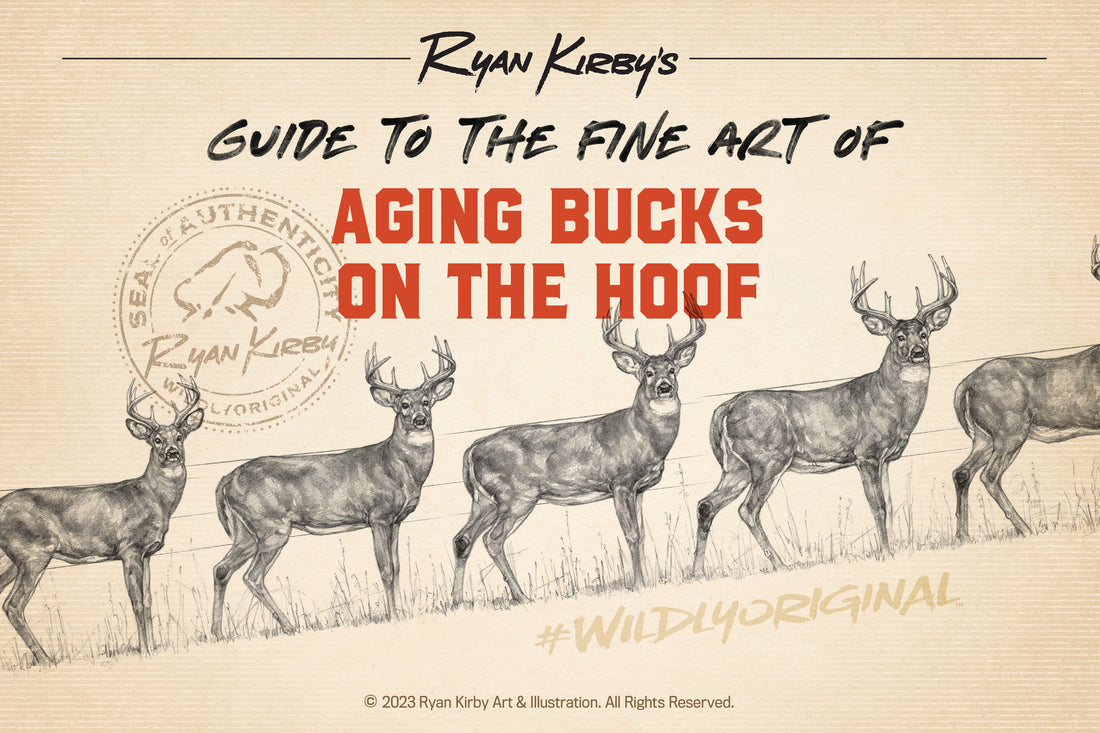As an artist, I’ve spent my entire career studying the characteristics and features of white-tailed bucks to paint them. As a bowhunter, I’ve spent those same years studying their habits and behavior to hunt them. Five years ago, these passions came together in my best-selling print “The Growth & Maturity of the White-tailed Buck.”
Since that time thousands of die-hard deer hunters (and the spouses that have an eye for quality gifts) have hung this print in their homes, offices, and deer camps. It’s so much more than just a chart on how to age deer – it’s a celebration of the life cycle of North America’s greatest big-game animal.
I spent months drawing, researching and working with the finest deer biologists in the country to refine the art and information in this print. Here's what I learned:

1.5 YEAR OLD BUCKS
Young, slender, and lanky, the 1.5 year old buck is in his first year away from his mother. Research shows that 50-75% of them will disperse an average of 1-5 miles to establish their own range. Generally, the 1.5 year old will stay clear of larger bucks, breeding more in areas where mature bucks are less frequent.
His back line is straight, but angling up towards the rump, as if the back legs are longer than the front. Rump is lean, angular and appears larger than the shoulder. His small, thin rack has only achieved 15-25% of antler growth potential and his tarsals have little to no staining, as he’s only in his rookie year of rut activity.
Research shows yearlings and 2.5 year olds sire about 33% of fawns in populations with good age structure.

2.5 YEAR OLD BUCKS
Awkward, gangly, and highly visible during the rut, the 2.5 year old talks a big game but will still shy away from most older, larger bucks when push comes to shove. Like a rapidly growing teenager, most of the buck’s energy is devoted to skeletal growth at this age, leaving less available for antler development and body mass.
His back line is still straight but beginning to level out between the rump and shoulders. The rump appears angular and larger than the shoulders, with a tight stomach. His legs still appear too long for the body and although he may have longer tines and a rack as wide as his ears, he’s only achieved 25-50% of antler growth potential.

3.5 YEAR OLD BUCKS
Athletic, lean, and toned, the 3.5 year old whitetail can sport an impressive rack and participates heavily during the rut, often settling into a home range at this point in his life. Still, he’s only achieved about 50-75% of his antler growth potential, with his best years yet to come.
For the first time, the buck’s legs do not appear too long for the body. His back line is straight and his rump is now full and rounded, yet his stomach is not yet sagging. The buck’s shoulders appear larger than the rump for the first time.

4.5 YEAR OLD BUCKS
Broad, thick & strong, this is the age that most hunters would deem the buck mature for their area. He’s reached his physical prime and is very rarely outmatched in the dominance hierarchy. The buck has also reached 75-90% of his antler growth potential and breeds multiple does during the rut.
At this age, the buck has reached full skeletal maturity and can now devote more energy to antler development, resulting in large gains. His back and stomach may begin to sag slightly and his shoulder appears the same height as the full, rounded rump.

5.5 YEAR OLD BUCKS
Mature, bulky and dominant, the 5.5 year old is king of the hill. This age class of buck competes heavily with rivals and come hell or high water, he’ll breed as many or more does than he did the previous year. Of particular interest to hunters is that at 5.5 years old, he’ll typically sport the largest rack of his entire life.
He’s developing a noticeable sag in the back and stomach and his rump is full and rounded, so much so that his legs are starting to look short compared to his massive body. His tarsals are large and dark from rub urinating on them during the rut. His head appears short at profile and may begin to exhibit a “Roman” nose. The neck is massive, powerful and connects to the body just above the brisket.
The average age of a whitetail entered into the Boone & Crockett Record Books is 5.5 years old.

6.5+ YEAR OLD BUCKS
Heavy, saggy and short, the 6.5-year-old buck has some serious old-man strength. He may not be as good as he once was, but he’s as good once as he ever was. His back and stomach have a pot-bellied appearance, as gravity is taking its toll on the aging buck. His rump is fully rounded, and shoulders are still very large.
It’s possible he’s a late bloomer and this is the year of his largest rack, but chances are he’ll begin to decline through subsequent years. At profile view, his chin is often sagging while his muzzle is gray and the forehead dark. Speaking of dark: his tarsals are nearly black, with stains running all the way down the inside of the leg. Scalding is common from years of rub urinating on his hocks.
A buck is still considered to be in his prime until he reaches around 8.5 years of age, at which point his body and antler size, activity and dominance begin to decline. Deer in the wild are capable of reaching ages upwards of 15 years old, but almost never older than 20.

As an artist, it’s my passion to enhance the atmosphere of deer camp. The best way I know to do that is through my best-selling paper prints “The Growth & Maturity of the White-tailed Buck" and “The Anatomy & Physiology of the White-tailed Buck.” The above art and information (plus much, much more) can be found in one place that you can hang on the wall. It’s been an honor to produce them, and I guarantee you they’ll be the talk of hunt camp!
Wishing you a successful deer season,

Get my two most popular prints for 25% off in the Art of Hunting Bundle!



